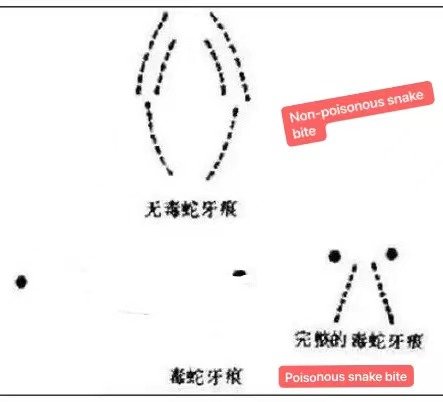Dealing with Venomous Snakes in Beijing
A Chinese Krait, a highly venomous, black-and-white striped snake commonly found in central and southern China, was spotted by locals recently around the Wangjing East Road, according to a report from NetEase.
While the Chinese Krait isn't native to northern China, it's common to run into snakes in parks or along hiking trails in the summer months. Plus, although the krait doesn't call Beijing and it's surrounding areas home, there are a few common venomous snakes that should be avoided. They are as follows.
Short-Tailed Pit Viper 短尾蝮蛇 Duǎnwěifù shé

Short-tailed pit vipers are very common in Beijing, especially in the Western Hills and western suburbs of Haidian District, as well as low altitude mountainous areas of northern Beijing. Short-tailed pit vipers can be aggressive when disturbed.
The surface of the pit viper is light bown to reddish brown, with two lines of round dark brown spots. The center of the spots are lighter in color, and the edge of the spots is often in the shape of a horseshoe.
Siberian Pit Viper 西伯利亚蝮蛇 Xībólìyǎ fù shé

This snake is mainly distributed in higher-altitude meadows and dry mountainous areas of Beijing. It can also be found in suburban areas including Huairou, Yanqing, Fangshan, and Metougou Districts. While this snake is certainly venomous, it's less aggressive compaired to the short-tailed pit vipers.
Siberian pit vipers are grayish, pale brown or yellowish, with large dark spots on their backs. Behind their eyes is a wide, dark stripe, bordered by light stripes both above and below.
Gobi Pit Viper 华北蝮 Huáběi fù

Gobi pit vipers can be found in the high altitude areas around Mentougou District, namely around Baihua Mountain, Xiaolongmen, Miaofeng Mountain and Lingshan Mountain. The snakes like to lie on platforms like rocks, fallen logs, or concrete steps in these scenic areas, so it's best to watch your footing with this one.
The Gobi pit viper has several dozen irregularly shaped splotches that look a bit like rings, overlying dark brown skin. The snake also has a lighter-colored belly, which may be heavily or lightly speckled.
What can I do if I am bitten by a snake?
First, here's what NOT to do:
1. DO NOT cut open the wound and/or try to suck out the venom. Once venom has entered the body via a bite, it spreads rapidly, and any form of suction won't take it back out, according to an article from Live Science. Plus, if the bite wound is opened this could result in excessive bleeding or more serious injury, so is best avoided.
2. DO NOT apply ice or a tourniquet. Ice won't do anything to prevent the spread of venom through the bloodstream, and using something to fashion a tourniquet in an attempt to stop the venom's flow could lead to restricting bloodflow to the affected area, which could make things worse.
3. DO NOT try to figure out whether the bite was from a venemous snake or not. While it is possible to discern a venemous from non-venemous snake based on teeth marks, it's safer to seek medical attention immediately rather than take any chances.

Here's what you SHOULD do if you're bitten:
1. Stay calm and keep still. Avoid any movement to avoid accelerated blood circulation, which can cause venom to spread more quickly.
2. Immobilize the limb that's been bitten and elevate it to at or below the level of the heart.
3. Apply a broad constrictive bandage to the whole limb, beginning at the site of the bite reaching to the extremities (fingers or toes) and continue application back up to the limb as far as possible. This is to limit the spread of venom.
4. See if you can get a photo of or remember what the snake looked like. This will ensure the proper antivenom is used when getting medical help.
5. Seek medical attention immediately. Either get to a hospital or dial 120 for an ambulance. If you're in a rural or mountainous area, get to a populated area and seek help from there.
Note: While a number of sources said to wash the wound and dry it gently, others (especially the source from the University of Minnesota, listed below) said to not wash the wound so as to keep any venom residue there for quicker identification and administration of a proper antivenom.
Sources: American CDC (https://www.cdc.gov/niosh/topics/snakes/symptoms.html) and University of Minnesota
READ: Three Waterside Spots Where You Can Escape the Heat
Images: Baidu, 北京交通广播, David Clode via Unsplash







